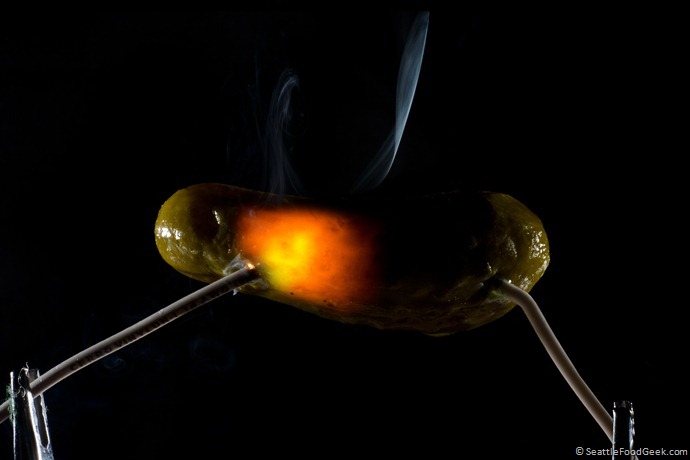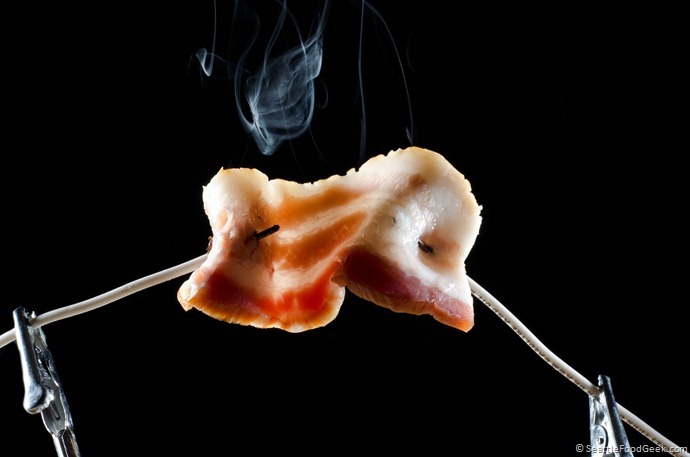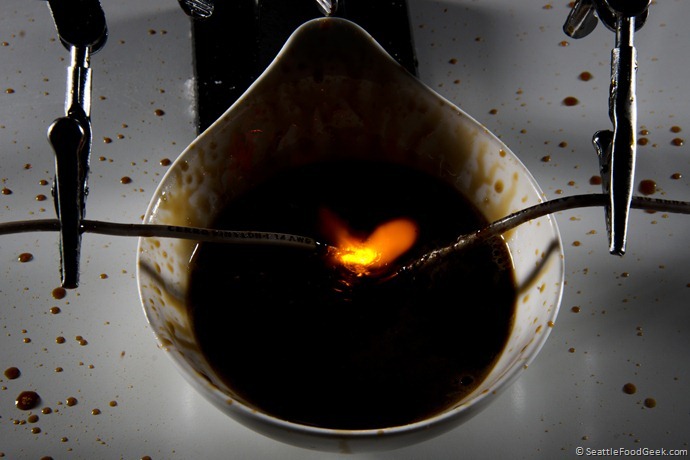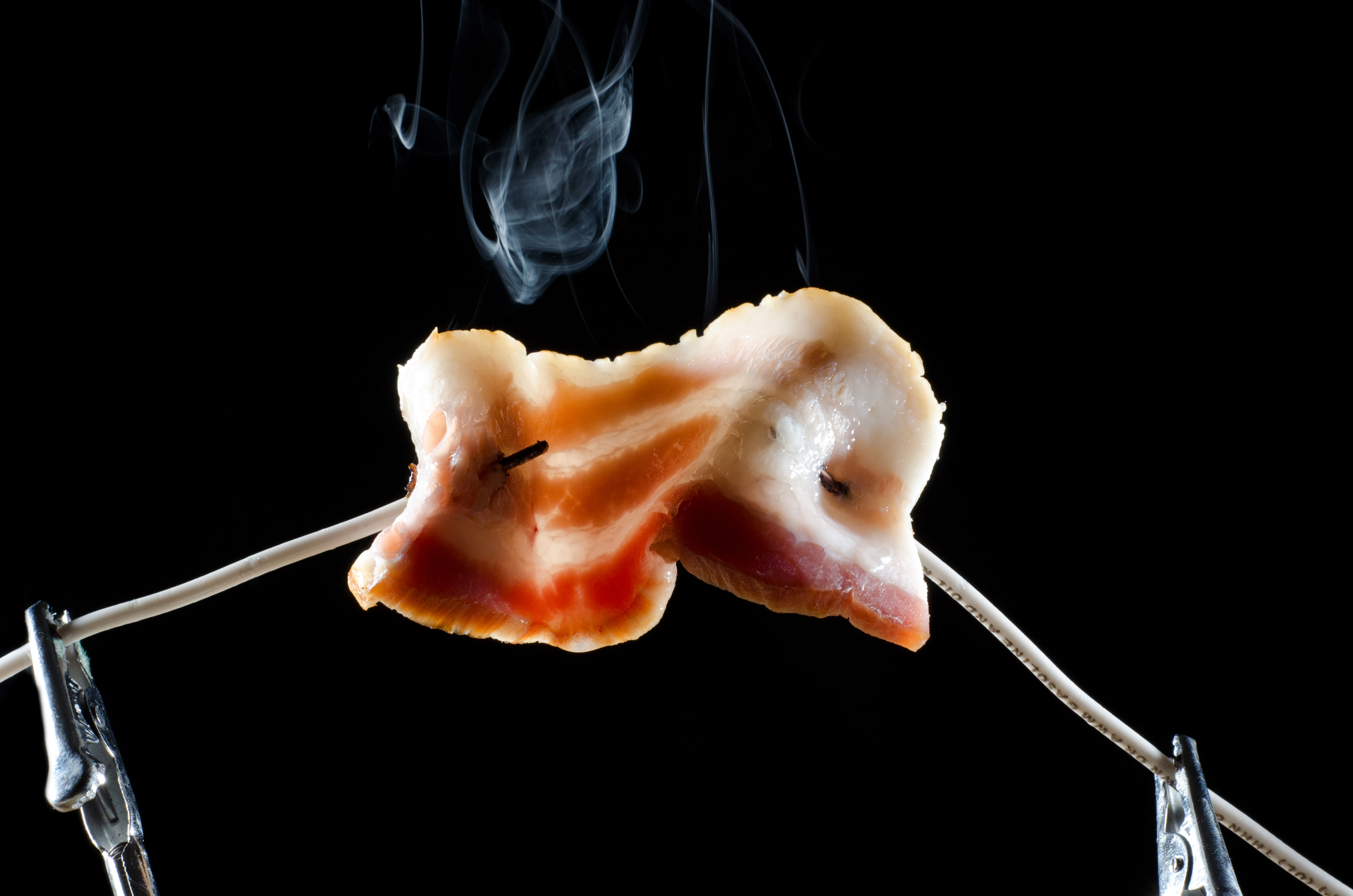If you were lucky, your eighth grade science teacher demonstrated the surprising effect of plugging a pickle into a household power outlet. The pickle glows bright orange for a few seconds, then starts to smoke and smell like burning. The phenomenon is caused by the electricity exciting the sodium (salt) in the pickle, causing it to emit light.
I wondered what other foods I could get to glow, so I tested pickled asparagus, limes, grapefruit, apples, hot dogs, sauerkraut, bacon, ketchup and soy sauce. Keep reading to see the results.

The pickle worked like a charm, of course. Pickles are brined in a high-sodium solution until the salt is distributed throughout the interior of the pickle. When I turned the power on, the pickle flickered and hissed a very menacing hiss, giving off the same orange glow as the sodium lights that line most city streets.
I was hopeful for the acidic foods like pickled asparagus, lime and grapefruit. Although those foods don’t have very high sodium, for some reason I assumed that they’d still produce a similar reaction. I was wrong. The high voltage did heat up all of those foods in short order, but they barely produced a spark. Apples, however, neither got hot nor sparked at all. The next time I need to shield myself from a lightning strike, I’ll hide under a pile of Red Delicious.

I did get some sodium activity from hot dogs and sauerkraut, but it wasn’t quite as dramatic as the fireworks display from the pickle. The bacon also produced very few sparks, but interestingly, it began to cook after only a few seconds of power. The bacon fat sizzled and smoked and after a minute or two, the bacon started to take on a cooked appearance. Given that the ends near the wire connections were singed and black, I decided not to make taste testing a part of this experiment. However, if I found myself trapped in the basement with only an extension cord and a week’s supply of uncooked bacon, I’m confident that I could MacGyver my way through breakfast.

Given that the saltiest foods appeared to produce the best results, I reached for two of the highest-sodium condiments in my pantry: ketchup and soy sauce. The ketchup lit up instantly, bubbling and smoking while it zapped away. After a moment, I could smell the caramelization of the sugars in the ketchup –it was the same aroma you get from frying tomato paste. Next, I dipped the wires into a bowl of soy sauce and flipped the switch. If you had any doubt about how much sodium is in soy sauce, let the video above set the record straight. More than any other food I tested, the soy sauce produced a startling reaction.
So what was the point of electrocuting my food? We use electricity in all sorts of ways to indirectly heat our food: electric stovetops, ovens, crock pots, toasters… all of those devices heat up metal coils which radiate or conduct heat to the outer surface of food. Passing electrical current through food heats it internally, warming the food itself instead of warming a heating coil. This technique could potentially allow us to precisely control the internal temperature of food for sous vide-like cooking without the water bath or the time spent waiting for heat to travel from the outside of the food to the core. It also has the potential to create surprising new flavors, or caramelize foods in new ways. It’s also just really fucking cool to play with.
Note: This experiment is easy enough to recreate if you take a few safety precautions. If you don’t already know what those precautions are, though, I wouldn’t recommend that you give this a try – you’ll probably die in a very painful and embarrassing way.

Ha! Great stuff, I’ve seen the pickle thing before, but never thought about using for anything other than laughs. What if you set up 2 plates across a small distance, charge up the plates using a capacitor and drip a tincture or something between the plates causing periodic breakdown. You have all kinds of parameters for controlling how much the liquid gets zapped, and you hopefully get a loud spark w/ every drop, too.
There used to be electric hot dog cookers that worked using this method.
Presto made them. The “Hot Dogger” http://www.etsy.com/listing/30422864/1970s-presto-hot-dogger-retro-electric
https://www.youtube.com/watch?v=St2USEfQxZU
@Linh That’s a great idea. I could totally see a way of presenting food using the setup you described.
@Sam That’s so cool – I had no idea that this product existed! I guess I’ll have to try electrocuting a hot dog again, but this time using food-safe electrodes 🙂
I wonder how long it would take to cook a turkey like this…
Delightful imagery! You mention cooking with this, and it does sound promising and well-worth investigation. One concern being ‘hotspots’ hastening the conversion of nitrates and nitrites to nitrosamines, which would not be ‘good eats’.
A July 4 PSA and reminder: Be responsible. Be safe. Only one can of black powder per mailbox!
@scott
Those presto cookers where in the early 70’s. Pre-microwave days.
As a side note my favorite old school appliance was a bacon maker.
Imagine something a bit taller than a toaster…inside was a heating ‘brick’ about the size of large hardback book, coated with teflon…the bottom was a drip pan, like a crumb pan for a toaster. The sides where fold down ‘wings’.
You draped the bacon over the ‘brick’ put the wings back up and set the timer.
Worked fantastic. I wish I could find one again. Ahh..this has a picture of the device. The Baconer.
http://plaidstallions.blogspot.com/2008/11/greatest-appliance-ever.html